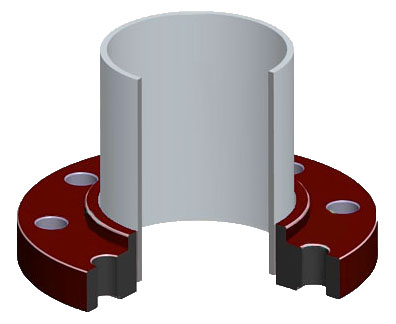An extremely strong precipitation hardened stainless steel
- Well suited for high strength applications
- Up to 4x stronger than 316 stainless steel
- Maintains its mechanical strength up to 600°F
- 17-4PH Chemistry & Specifications
- Slip on flange features and benefits
17-4 PH slip on flanges are made from a precipitation hardened stainless steel most known for its exceptional strength and its ability to maintain its mechanical properties to 600°F. Compared to 316 stainless steel, 17-4 PH slip on flanges yield strength is up over 4 times greater. When compared to Duplex 2205 slip on flanges, the yield strength of 17-4 PH can be up to 2- 1/2 times greater.
17-4 slip on flanges are available in 8 different aged (precipitation hardened) conditions offering a variety of mechanical properties (see below).
Resources: 17-4PH Torque Specs, Flange Dimensions, Flange Bolting Chart
Flange Types Available: Blind Flanges, Lap Joint Flanges, Slip On Flanges, Socket Weld Flanges, Threaded Flanges, Weld Neck Flanges
17-4PH Chemistry & Specifications
17-4PH Specifications: UNS S17400, AISI 630, ASTM A564-630, AMS 5604 Sheet, Strip and Plate, ASTM A 693 Plate, Werkstoff 1.4542
This specification covers bars and shapes (such as fasteners) of age hardened stainless steels such as 17-4PH. It includes hot-finished or cold-finished fasteners that are produced by hot rolling, extruding, or forging. Grade 630 shall be furnished in the solution-annealed or or age-hardened condition.

Common 17-4 Slip On Flanges: Aged Conditions vs Tensile Strength

17-4PH Slip on Flange Features & Benefits
17-4 PH slip on flanges are similar to the socket weld flange but without the socket shoulder. When using a socket weld flange, the pipe rests against this internal shoulder. Since a slip on flange does not have shoulder, the pipe can slide completely through the flange hub and is free to spin.
Advantages
- Typically lower in price than weld-neck flange, yet welding costs can be more.
- There is a reduced need to cut the pipe length accurately, making it easier to install.
- The slip on flange is free to spin on the pipe for easy bolt alignment.
Disadvantages
- They require two fillet welds: one fillet weld at the hub of the flange and a second weld at the inside diameter of the flange near the flange face.
- Though they can be used for high temperature and pressure applications, they typically are not as other flange types give a more secure joint.
